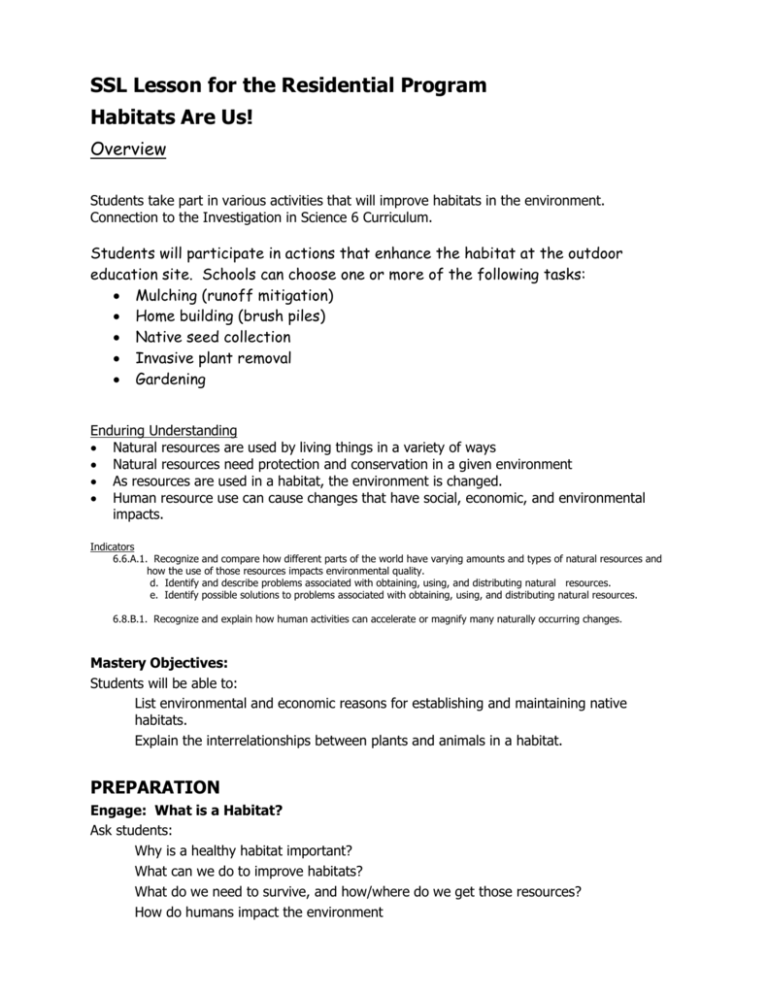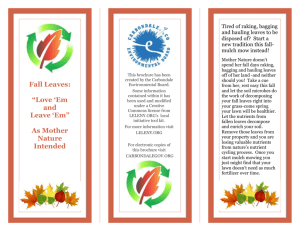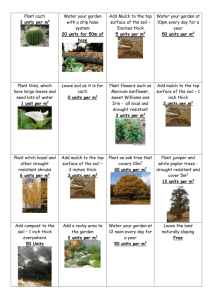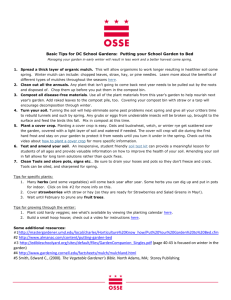Project Details
advertisement

SSL Lesson for the Residential Program Habitats Are Us! Overview Students take part in various activities that will improve habitats in the environment. Connection to the Investigation in Science 6 Curriculum. Students will participate in actions that enhance the habitat at the outdoor education site. Schools can choose one or more of the following tasks: Mulching (runoff mitigation) Home building (brush piles) Native seed collection Invasive plant removal Gardening Enduring Understanding Natural resources are used by living things in a variety of ways Natural resources need protection and conservation in a given environment As resources are used in a habitat, the environment is changed. Human resource use can cause changes that have social, economic, and environmental impacts. Indicators 6.6.A.1. Recognize and compare how different parts of the world have varying amounts and types of natural resources and how the use of those resources impacts environmental quality. d. Identify and describe problems associated with obtaining, using, and distributing natural resources. e. Identify possible solutions to problems associated with obtaining, using, and distributing natural resources. 6.8.B.1. Recognize and explain how human activities can accelerate or magnify many naturally occurring changes. Mastery Objectives: Students will be able to: List environmental and economic reasons for establishing and maintaining native habitats. Explain the interrelationships between plants and animals in a habitat. PREPARATION Engage: What is a Habitat? Ask students: Why is a healthy habitat important? What can we do to improve habitats? What do we need to survive, and how/where do we get those resources? How do humans impact the environment Generate a list of tasks that might be accomplished at OE: -removing invasive species - gardening -mulching/erosion mitigation -seed collection -home (habitat) building ACTION Explain: Review beneficial impact of selected task(s) on the habitats involved and highlight: What we’re doing; Why we’re doing it; How to get it done Explore: Take the students to the appropriate location and work on the selected task(s). REFLECTION Evaluate: Students write about their learning in their journals. This can be done during the SSL class or during time after the session. Guiding questions for students: o What is the environmental benefit of your service? o Who benefitted from your service? o Did you learn anything about yourself? Explain. o How was your service-learning connected to something you studied at school? Students will use their reflection to help complete the SSL Activity Verification form during the SSL class or in large group as a wrap up. Teacher Resources The Nature Conservancy MD/DC www.hature.org/maryland/invasives Maryland Native Plant Society www.mdflora.org National Park Service www.nps.gov/plants/alien Habitats Student Service Learning Projects Planning information Best done in the fall or spring since the activities are done outside. Native seed collection is only done in the fall Allow at least 45 minutes that includes preparation/learning, action, and reflection. Site information (discuss your plan with your coordinator before the program) o Smith Center – all are available o Summit Lake – invasive removal, brush piles, seed collection o Skycroft – invasive removal, seed collection These action projects can be led by teachers, parents and/or high school counselors. Make time in your schedule while you are on site during your program for the coordinator to orient the instructors. Mulching Background Mulching is the act of placing a protective barrier (mulch) around your plants and over your bare soil. This protective barrier can be made up of a variety of organic materials including bark or wood chips (from various tree species), pine needles, straw, and even cocoa bean shells. The environmental benefits include: Weed Control: Through the use of mulch you can limit the amount of weeds that tend to spring up in the open spaces of your garden, because the mulch acts as a barrier, limiting the amount of sunlight that can find its way to the weeds. Retain Moisture: Retaining moisture, especially during hot, dry seasons can not only help out your plants, but it can also help out your water bill. Erosion Prevention: Mulching not only keeps existing water trapped in the soil but it also keeps rain water from washing away your soil. It does this by breaking the fall of the water and therefore lessening the force when the water impacts the ground. Maintains Soil Nutrients: No only does mulch keep soil nutrients from being washed away with the rain, but it also can release nutrients into the soil if you are using an organic material. This happens as the organic material slowly decomposes on top of the soil. Pest Control: Using certain types of mulch, such as cedar bark, can deter certain pests due to the fact that the cedar bark has natural oils that act as insect repellant. To reap the full benefits of this, be sure to find mulch that is very fragrant, as it will have the greatest affect on insects. But be warned, some mulches can encourage insects to flock to your garden and sometimes your house, so be sure to research which type of mulch will best suit your needs. Encourage Earthworms to Move It: Using organic material for mulching can encourage earthworms to occupy your garden soil. And as any good gardener will tell you, earthworms help improve soil structure and nutrient cycling. Adapted from http://www.doityourself.com/stry/why-mulch-6-benefits-of-mulching Project Details Piles of mulch are located near the learning cottages. Carts can be used to move the mulch to the designated areas. Students can take turns filling the carts and mulching. Students should wear gloves and can spread mulch with their hands or with rakes. It is helpful to weed or rake leaves from the area before spreading mulch. The leaves and weeds can be carted to the discovery compost garden next to the barn for removal. Mulching Open Areas Know your area boundaries – talk to your coordinator beforehand Spread mulch about 2-3 inches thick – but remember more is always better Return equipment to the shed at the end of the session Mulching Around Trees Identify trees or garden areas with your coordinator beforehand Model proper mulching technique for trees – create a donut around the tree, not a volcano Garden mulching requires more hand work. Please rake leaves and pull weeds in the garden before spreading mulch. Return equipment to the shed at the end of the session Removal of Invasive Plants Background Most plants introduced to our country or region are beautiful and productive additions. Some, however, have escaped to become invasive and destructive. Known as non-native, exotic, or alien invasive plants, they spread unchecked because their natural controls--disease and predators--were left behind in their land of origin. Today they cost agriculture, industry, and government billions of dollars a year to control. Invasive plants threaten our native plants and animals. Some native plants face extinction. Native wildlife suffers because it evolved dependent on native plants for food and shelter. All invasive plants have one thing in common – mechanisms to colonize, out-compete, and exclude native vegetation. A few of the tactics they employ are: rampant growth rate, extra-long growing season, blocking light from other plants, monopolizing nutrients and water, prolific and multiple means of reproduction, seeds that stay viable in the soil for many years, and toxins in roots or leaves that stunt other plants. Garlic Mustard: Alliaria petiolata) Garlic mustard is native to Europe and has spread from its original range. Within the U.S., the largest populations are in New England and the Midwest. It is one of the few non-native plants capable of invading and dominating forest understory communities. Its tolerance of low light levels, coupled with its high seed production and ability to spread rapidly, make garlic mustard a strong competitor. It diverts resources from native spring woodland plants such as spring beauty, trout lily, jack-in-the-pulpit, violets, and golden ragwort and many others. The deer don’t it eat!. Vietnamese/Japanese Stiltgrass: (Microstegium vimineum) Stiltgrass is native to Japan, Korea, China, Malaysia and India. It is a bright green grass that has silver hairs down the center of its short bamboo-like blade. Stiltgrass invades and alters disturbed soils in sun or shade. In fall, this Asian annual elongates quickly, then produces seed banks which stay viable in the soil for years. Mile-a-minute: (Persicaria perfoliata) Mile-a-minute weed, or Asiatic tearthumb, is native to asia and is an herbaceous, annual, trailing vine. Stems are armed with recurved barbs which are also present on the underside of the leaf blades. The light green colored leaves are shaped like an equilateral triangle and alternate along the narrow, delicate stems. Distinctive circular, cup-shaped leafy structures, called ocreae, surround the stem at nodes, and the flower buds emerge from this area. Flowers are small, white and generally inconspicuous. The fruits are attractive, deep blue and arranged in clusters at terminals. Mile-a-minute weed grows rapidly, scrambling over shrubs and other vegetation, blocking the foliage of covered plants from available light, and reducing their ability to photosynthesize, which stresses and weakens them. In addition, the weight and pressure of the vine causes distortion of stems and branches of covered plants. If left unchecked, reduced photosynthesis can kill a plant. Project Details Meet with your coordinator ahead of time to become familiar with the removal areas and identification guides. Gather equipment: gloves should be used for mile-a-minute since it has thorns, identification guides, and trash bags Divide students into groups so each group can focus on one species. Share the identification guides with the groups. Place all plants that are removed into garbage bags, tie them off, and leave bags in the compost area/Discovery garden Return equipment at the end of the session Removal Tips No tools needed, just wear gloves if you’d like. Pick EVERY visible plant with stems It's better to get every plant from one place than to get most plants from two places. Leaving a plant is like sowing a hundred seeds. If stems frequently break at the root, wiggle the stem before pulling. Search a bit for a broken root and remove. Be prepared to pick with little talking - it takes concentration to get every plant! Pick a handful, and later gather handfuls to larger piles placed prominently on paths. When stems grow closely in loose soil, gather several with one hand motion. Home Building – Brush Piles Background All animals require food, water, shelter, and space to survive. We can help create shelter, or cover for animals, and help keep our site safe for students. Brush piles are excellent hiding places for mammals like rabbits, skunks, raccoons, woodchucks, chipmunks, as well as birds like white throated sparrows, juncos, and ruffed grouse. If these animals survive, their predators can also benefit. Grasses and small plants can grow up in the brush pile to create more cover and food for the animals. Project Details Start on the left side of the predator prey field. You will see the existing borders (look hard – they have gotten a lot smaller and almost non-existent in places). The orange flagging tape around trees also designates the border of the simulation area. Take any large branches, especially the green pine branches, and pile them on top of the existing borders. Work gloves are available upon request. Also, please take trash bags to collect any trash in the forest. Native Seed Collection Background The Smith Center is a collection site for the Potomac Conservancy’s Growing Native program in which volunteers collect native tree seeds across the region for local nurseries. Hardwood seedlings are needed to support expanding reforestation and restoration efforts in the Potomac River watershed. Maryland and Virginia state nurseries are experiencing a shortage of native seedling stock due to the ever-increasing demand for trees, particularly for new streamside forest projects. A majority of this program's tree seedlings are used to create diverse and healthy riparian buffers. Riparian buffers are natural vegetative filters that are located between upland landscapes and waterways. They have positive effects on habitat, water quality and air quality. Riparian buffers provide food, shelter, travel corridors and breeding space for wildlife on the land and in the water. They filter excess nutrients from surface runoff before the water enters the waterway. And, trees and plants in the buffer capture rainfall and pollutants from the air and change the chemicals into useful carbon compounds. Project Details Meet with your coordinator ahead of time to become familiar with the site collection areas and seed identification guides. Gather guides and bags for collection Divide students into small groups – each group will focus on collection one type of seed. Each bag must contain only one species and be labeled with species name and weight to the nearest pound. Place bags in large Tupperware container on the front porch of the Smith Center or give the bags to your coordinator to bring back to the Smith Center. Gardening Background Gardens are a beautiful addition to yards and our outdoor education sites. Lawns have little habitat value, but gardens have many: they filter and conserve water, provide food, water, and shelter for wildlife, and we can eat the crops! At the Smith Center we have a few goals – to prepare vegetable gardens for spring production and create gardens with native plants for attracting wildlife and transplanting. Project Details Activities for the garden will depend on the season and may include: digging a new garden, weeding, adding mulch, planting seeds in the greenhouse, transplanting plants, putting up fencing, and harvesting. Discuss the tasks needed with your coordinator before your program. Gather equipment from the tool shed or greenhouse Divide students into groups based on task/equipment Return equipment at the end of the session Removal of Invasive Vines Background Most plants introduced to our country or region are beautiful and productive additions. Some, however, have escaped to become invasive and destructive. Known as non-native, exotic, or alien invasive plants, they spread unchecked because their natural controls--disease and predators--were left behind in their land of origin. Today they cost agriculture, industry, and government billions of dollars a year to control. Invasive plants threaten our native plants and animals. Some native plants face extinction. Native wildlife suffers because it evolved dependent on native plants for food and shelter. All invasive plants have one thing in common – mechanisms to colonize, out-compete, and exclude native vegetation. A few of the tactics they employ are: rampant growth rate, extra-long growing season, blocking light from other plants, monopolizing nutrients and water, prolific and multiple means of reproduction, seeds that stay viable in the soil for many years, and toxins in roots or leaves that stunt other plants. Project Details Meet with your coordinator ahead of time to become familiar with the removal areas and identification guides. Gather equipment: gloves Divide students into groups to work on specific areas As vines and plant matter are removed, pile them along the edges of the work area, keeping them in the woods. Please do not pile them on grassy areas, trails, or roads. Return equipment at the end of the session Removal Tips No tools needed, just wear gloves if you’d like. It's better to get every plant from one place than to get most plants from two places. Be prepared to pick with little talking - it takes concentration to get every plant!






